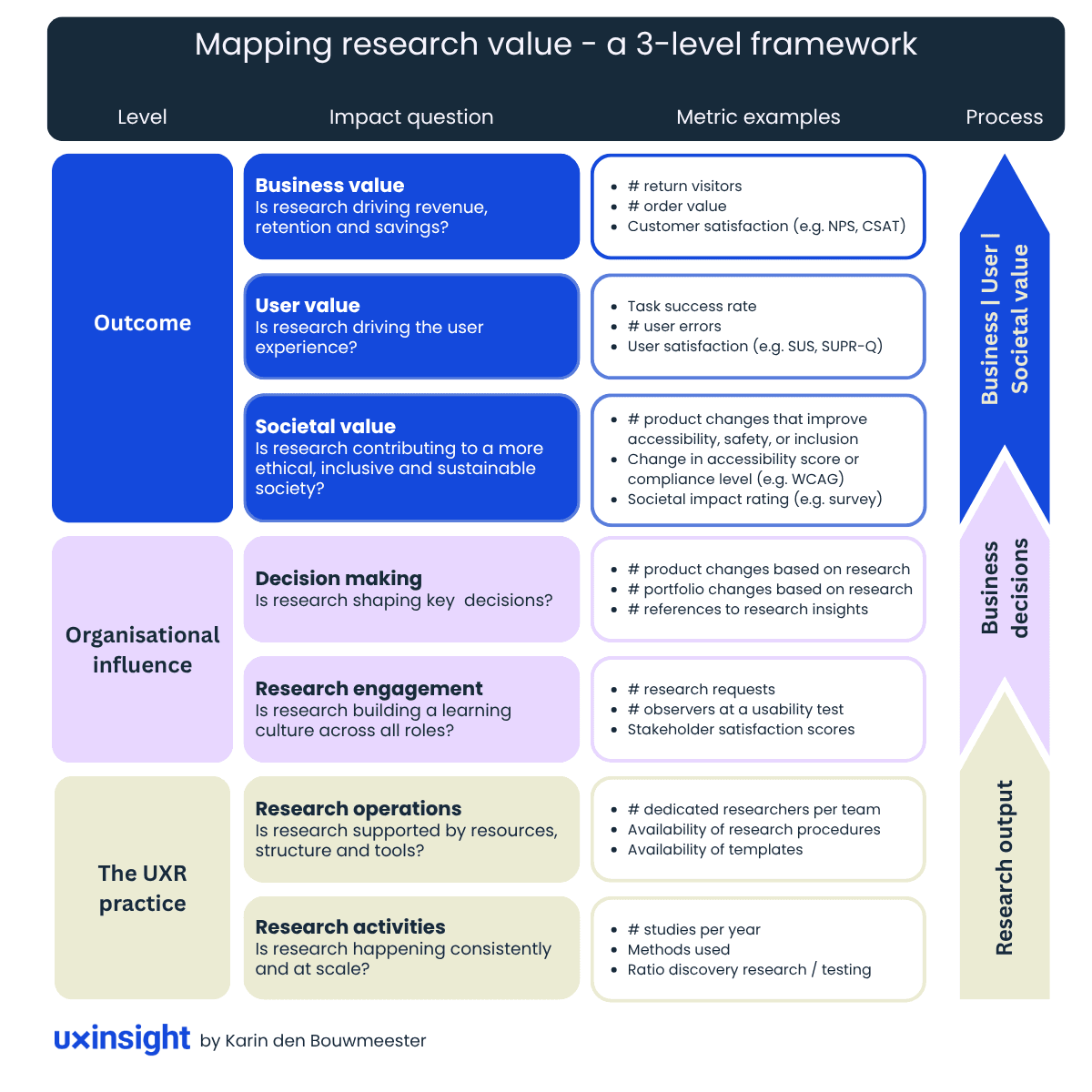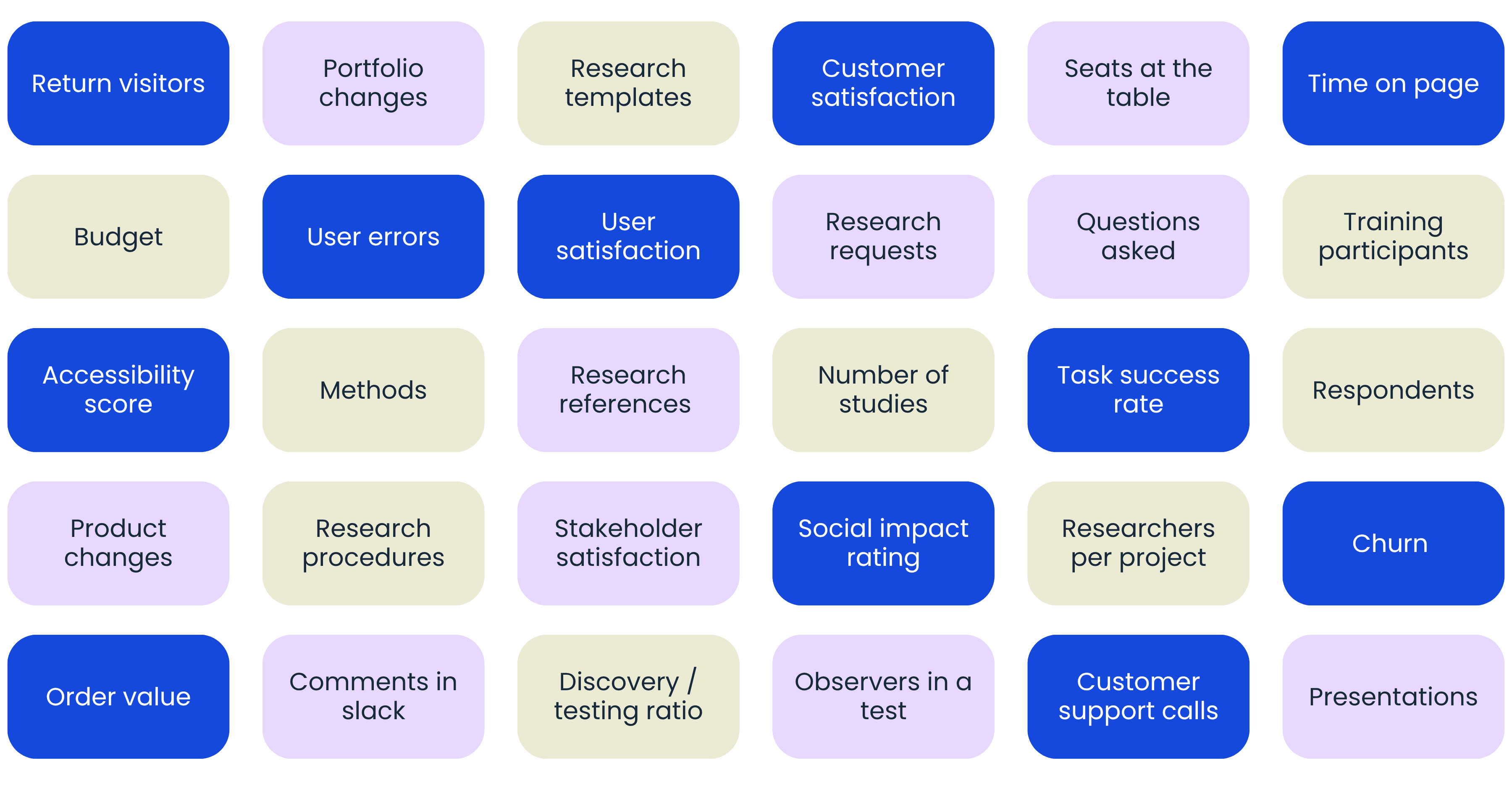* Last updated: 03/06/2025
You might be busy conducting research, but what if most of it ends up collecting dust in a shared drive or stakeholder inbox? Whether you’re the only UX researcher in your organisation or part of a larger team, it’s worth regularly reflecting on the impact your work has.
But how do you define and measure UX research impact? What frameworks can help us track it meaningfully? These are the questions I asked myself — and the UX research community — over the past years.
As I explored the topic and reviewed existing models, I noticed that different resources focus on different aspects: some emphasise UX metrics, others ROI, or how research informs strategic decisions. Each of these is valid, impact isn’t one-dimensional.
Introducing the Multi-Level UXR Impact Framework
In 2023, I introduced a model to help UX research teams map and reflect on the impact of their work. Since then, I’ve had the chance to test it in conversations, hear feedback from peers, and apply it in different types of organisations.
The core idea remains: UXR impact happens at different levels, and it helps to make those levels explicit.

The framework explained – How to measure UX research impact on 3 Levels
Level 1: Outcomes — What value does research create?
- Business Value – UX research doesn’t just improve usability, it also supports business outcomes. Does your work help reduce risk, increase retention, or improve ROI? Stakeholders often need this view to justify investment in research.
- User Value – Are we improving experiences for real users? Supporting their goals, increasing satisfaction, and making products more accessible and intuitive?
- Societal Value – Are we contributing to more inclusive, ethical, or sustainable solutions? Are underserved communities being represented in our products? Are we reducing harm or bias?
Level 2: Organisational Influence — Is research driving change?
- Decision Impact – Are research findings being picked up and acted upon? Are they shaping product strategy or informing roadmaps?
- Stakeholder Engagement – Are stakeholders actively participating in the research? Are they observing our usability tests, asking questions, and requesting research? A culture of engagement often drives greater impact downstream.
Level 3: Research Practice — What are we doing and how?
- Research Operations – Is research supported by solid infrastructure, transparent processes, tools, and resources? Is research part of the default development cycle or still an afterthought?
- Research Activities – How much research is happening, and when? What’s the balance between discovery and evaluative work? Consistent, strategic research builds the foundation for broader influence.
How to Decide What to Measure
Don’t try to track everything. Start with the level that aligns best with your team’s current goals and challenges.
Some examples:
- If your team is new and still proving its value, focus on business outcomes and product impact.
- If you’re highly involved in late-stage testing but want to influence early-stage strategy, track types of research and stakeholder engagement.
- If you’re advocating for increased headcount or budget, demonstrate how well the research is supported and what impact it enables.
“But how do we prove it was research that made the difference?”
A great question and one I hear often. I loved how Marieke McCloskey and Ruby Pryor addressed this at UXinsight Festival 2025.
It’s not about proving a perfect causal link. It’s about telling a credible, connected story.
Like this:
- We ran 5 studies on Topic X (Level 3)
- This led to 3 changes in the product (Level 2)
- And since then, NPS rose from 42 to 55 (Level 1)
You’re not claiming research was the only driver, but you’re making a compelling case for its contribution.
Want to apply this model in your own team?
I use this framework in my consulting, workshops, and team training, helping research teams reflect, align, and measure what matters.
👉 Interested? Send me a message or connect with me on LinkedIn.
Let’s make the value of research visible together!
Resources
- Tracking impact of day-to-day UX Research activities – by Kanishk Shukla
- Tracking the impact of UX Research: a framework – by Caitlin Sullivan
- How to Track the Impact of Your UX Research – by Lizzy Burnam
- A Framework for Demonstrating Research Impact – an interview with Brandie Smith
- Impact & UX Research: What Is It and How Do We Know We’ve Achieved It? (video) – by Victoria Sosik
- Impact mapping
- Why UX Outcomes Make Better Goals Than Business Outcomes – by Jared Spool
- The Need for Quantifying and Qualifying Strategy – by Itamar Medeiros
- Track UX Research, Prove its Value (video) – by Ana Filipa Couvinhas
- Measuring the internal success of user research – by Nikki Anderson
- Signs UX Research Is Making an Impact – by Tomer Sharon
- 10 Metrics to Track the ROI of UX Efforts – by Jeff Sauro
🙏 Thanks for the resources and for sharing your ideas on impact measurement: Anouk Scholten, Vitaly Friedman, Marieke McCloskey, Ruby Pryor, Katie Kelly, Tudor Cristian Bogdan, Bas Bakker, Maurice Beerthuyzen, Kathleen Asjes, Itamar Medeiros, Joana Cerejo, Chris Jager, Julie Krohner, Laura Wells & Ana Filipa Couvinhas!




